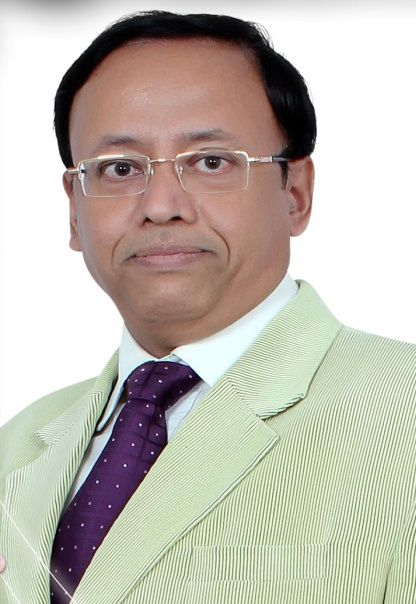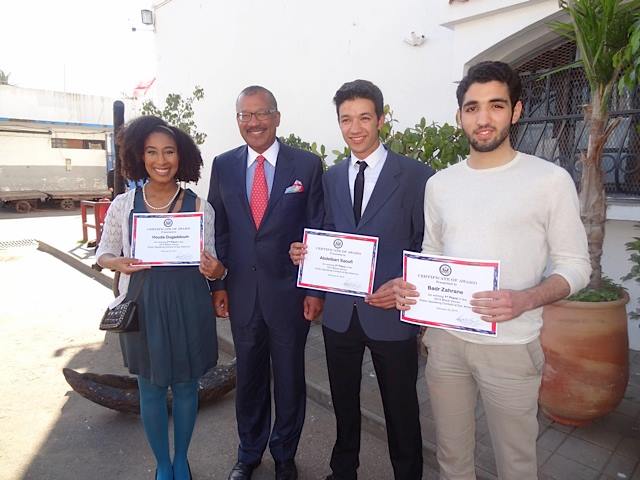[symple_box color=”blue” text_align=”left” width=”100%” float=”none”]![]() Dr. Mohammed Maarouf is a professor at Chouaib Doukkali University, El Jadida, Morocco. Dr. Paul Willis is a professor at Beijing Normal University, China.[/symple_box]
Dr. Mohammed Maarouf is a professor at Chouaib Doukkali University, El Jadida, Morocco. Dr. Paul Willis is a professor at Beijing Normal University, China.[/symple_box]
El Jadida, Morocco—The maraboutic scene continues today across the Moroccan countryside with many holy maraboutic shrines still dotting the landscape with their white exterior walls, domed shapes, and inside imbued with saintly chants, dances and perfumes. Maraboutic rituals from jinn evictions to trance dances appear to fulfill individual needs, especially psychological and emotional ones producing comfort, hope and relief from uncertainty, anomie and unhappiness. They also respond to the immediate needs of society by trying to answer to problems of sickness and economic and social malaise, and maintain social cohesion.
Folk music thrives with a plethora of maraboutic spirits and tunes evoked in ecstatic trance dances (hadras) and jinn evictions. The epistemic foundations of these practices are bizarre to the schooled who may rationalize things in terms of material empirical beliefs, and for whom these pursuits seem to be mystifying rather than mystic, serving finally only social and political obfuscation.
But we argue that the surviving and still-working culture of possession and maraboutism may indeed shed light on what most Moroccans feel towards the current political and economic order and how they may resist political domination and economic injuries. Deep down in their cultural logics, possession rituals and trance dancing can be understood as a form of cultural resistance against domination.
There are many strands to our argument. Theoretically speaking, spirit possession presupposes the permeability of the body; powerful external forces which could not be assimilated in their abstract forms enter as divinities, ancestors, ghosts, jinn, and have a hold on the body. They are still seen as separate and distinct— certainly detachable—from the body, ethnically alien and foreign to the group. But they are somehow known and capable of some bidding and exist within a daily realm. It is a way of sensing incomprehensibly large and abstract structural forces which cannot be named directly in local cultural and concrete terms.
We argue that there are challenging forms in this mystic soil suitable for transplant to modern dilemmas. For instance, the spectral mythic court assembled during jinn eviction (like the court of Bouya Omar, Ben Yeffu, Sidi Chamharouch…) is at least a court—more than most Moroccans get in normal social life for the many social and economic injuries to which they are subject.
With possession at least the human hosts stand in some equal capacity with a personalized, if still incomprehensible force, scoped in the present body. This is not the crushing of insects without human color and imagination. If not controlling their fate, at least in an unlikely swallowing, there is a condensation of outlandish and truly frightening structural forces into the more amiable personification of jinn, mischievous, answering back and at least partly controllable.
The ingestion of wider social forces as an internal habitation at least recognizes the importance of a human scaling of impersonal forces. Further, the dual occupation of the body at least opens up, practically if not philosophically, just what the `autonomous` subject is supposed to be and to whose tune or to what discourse it is supposed to dance, all closed matters in the dominant register of how plebeian social agents are supposed to comport themselves as complaint subjects.
Of course it remains true that maraboutic politics of resistance are trapped in a vicious cycle of power co-opted in advance because the permeable and culturally drilled subject of maraboutic culture is enabled to enact symbolic re-articulation and displacement of power but without inventing new forms of subjectivity or destabilizing entrenched forms of being and knowledge.
In this sense, maraboutic resistance spins in a vortex of authoritarian relations fixed up in a priori ways by the maraboutic establishment. Counter-hegemonic aspects of trance dances and jinn evictions prevail but subalterns cannot through them escape their social position though they can sometimes escape the conventions that go with it. They can somehow be free at a symbolic level, transgress and be outrageous and throw out the norms at least for a while, a kind of magical but not real emancipation. This could be seen as a `ruse of power` to license a blowing off of steam, but those alternative meanings remain latent all the time and may be raised anew under appropriate socio-political conditions. Ecstatic religion has kept seeds alive that can be sown anew in different cultural soil.
Generally, the survival of jinn eviction and trance dance among the commoners signifies that any substantial move towards social emancipation has not occurred yet and cultural resistance can be seen as a displaced and phantasmal activity in which the oppressed exorcise danger in the imaginary without either daring to face or being mindful of the danger of the real oppressor. Any fear-inspiring coercive menace coming from social realities or unidentified powers may be personified and represented to the imagination under the in-visible form of jinn or evil. They are symbolized with a name, shape and social conduct.
Jews, for instance, whom Arabs cannot defeat in reality, are culturally represented as unbeatable spirits in Moroccan mythology. There is a clear consensus among curers and patients alike about Jewish jinn’s surpassing powers. They are thought to be the most harmful spirits. Just like their human counterparts, they are believed to be mendacious, may torture the body they visit and may delude the healer during their eviction.
The Black Sultan (sultan l-khal) is another mythic figure who has haunted the Moroccan popular imagination for centuries. He is a symbol of ruling terror and oppression in the popular mind. He is both undefeatable in reality and imagination. We have observed that patients who claim to be possessed by l-khal do not seek eviction but just mollification rituals such as trance dances and slaughters to settle peaceful contracts with his commands. Historically, sultan l-khal was a nickname given by the ‘amma (commoners) to Abu l-Hasan l-Marini or Mulay Ismail due perhaps to their black color. Mulay Ismail was reputed for his repressive arbitrary cruelty and promiscuous liturgies of torture and beheadings in public, intended to fill people’s hearts with terror. According to the hagiographic tradition, no earthly power could stand against his hostility save for the baraka of saints. Al-Haj Thami al-Glawi, who was a qaid in the Haouz region, was also nicknamed the Black Sultan.
Aicha Qandisha (the gentile name being a phonetic distortion of the Portuguese honorific title Condessa [noblewoman]) is another mythic figure albeit anti-hegemonic. In popular imagination, she is a source of fear and haunts the wilderness, the sea and the world of darkness. Historically, she was a female warrior during the Portuguese colonial times in Morocco. Her guerrilla tactics were unusually marked by luring soldiers to the wild and mutilating them. It was such savage killings and disfiguring of corpses she left behind her that struck terror in the indigenous people’s hearts to the extent that they started doubting whether the Condessa was truly human. The mythic terrors spun around her certainly demoralized the enemy’s will and devitalized his strength. The human actual female warrior might have died but she was eternalized in popular imagination as the princess spirit of the wild in shadows.
Another example from the jinn world is summoned by the word (pasha) attributed to a jinni named l-Basha Hammou (Hammou the Pasha). The word is a linguistic clue that locates the jinni in time and place. It refers to a Moroccan administrative title transferred to the jinn world, another example of how Moroccans project their imaginary fear of oppression on to the world of jinn. Like Moroccan society, the society of jinn seems to comprise sultans, qaids, bashas, and mkhaznis, all archetypal figures of oppression and terror in popular imagination.
According to the fqih exorcists we interviewed in our research projects, l-Basha Hammou is one of the kings of jinn (muluk l-jinn), an invincible jinni who frequents slaughter-places (nhira-s). He is a butcher who likes blood. The wooden corpse (khushba) he invades likes trance dance (hadra) and practices limb-slashing. For women he causes haemorrhage. These characteristics aid the unconscious collective projection of the real pasha, the oppressive figure who filled people’s hearts with terror.
In Moroccan mythology, then, the Jinn world mirrors the social world. Many Jinn are hegemonic projections of tyrant historical figures that have left imaginary but indelible scars on popular collective dignity. The example above of the jinni l-Basha Hammou, an imaginary mythologized construct of the real historical pasha, is a good case in point. In fact, there were actually two real historical oppressive qaids who held this name in Moroccan historical records: l-Basha Hammou Bel Abbas (1875-1975), who ruled Doukkala region with an iron grip during colonial times but whose verdicts and decrees Doukkali people chanted as fair in the slogan: “qaftanu kabriti u hkamu viriti” (his caftan is sulfur-colored and his rule is truth), and l-Basha Hammou, who died in 1900 and was buried in Sidi wa Sidi cemetery in Taroudant and who was chronicled to have chopped off heads that outnumbered the crenels of the town’s battlements.
We would argue though that the exact correspondences do not really matter here since the culturally mythologized representation of the pasha jinni is anyway indistinguishable from the social image of the Black Sultan. Both jinn could be mythic epitomes of the populations’ cultural fear from Sultans and officials whose governing power was draconic and inhuman in the history of Morocco.
The Issawi melodies originating from the once imperial city of Meknes as well as the sadomasochistic head-slashing ecstatic trances of Hamadasha all dramatize popular memories of resistance to the mythologized despotic rule of the Black Sultan, as well also enacting the social bloodstained drama of l-Basha Hammou–the blood sucker (shareb demmou). l-Basha Hammou and the Black Sultan’s symbolical and imaginary tortures though historically disconnected in time are all brought out and dramatized in the ritual hadra dance periodically performed to invoke their mythologized presence, and during which the population’s historical mistreatment and hampered hostility are enacted in domestic ritual dancing pantomimes. Such cultural models of hadra dances, to quote Fanon’s terms, may be regarded as “the huge effort of a community to exorcise itself, to liberate itself, [and] to explain itself”.
Although easily incorporated back into the system, the cultural representation of terror in the Moroccan popular imagination in the form of spirits symbolizes that subaltern cultural resistance through evictions and trance dances remains a vibrant cultural practice, providing a symbolic space for the masses to exert some power even though not changing or seriously challenging the real relations of power. Still possession shows aspects of resistance and self-hood that may expose and undermine the prevailing power if social circumstances change. So far it has legitimated social hierarchies and asymmetrical relations of power by revitalizing them in rituals. But containment is not defeat.
The seeds of rebellion and anti-hegemonic disposition still lurk beneath these mystic avatars. They are we insist always available for new cultural attachments under new social, political and economic conditions. The resistance and self-hood remain as resources for alternative kinds of expression under new forms and within new conjunctures.
[symple_box color=”blue” text_align=”left” width=”100%” float=”none”] Dr. Mohammed Maarouf is a professor at Chouaib Doukkali University, El Jadida, Morocco. Dr. Paul Willis is a professor at Beijing Normal University, China.[/symple_box]
Dr. Mohammed Maarouf is a professor at Chouaib Doukkali University, El Jadida, Morocco. Dr. Paul Willis is a professor at Beijing Normal University, China.[/symple_box]





